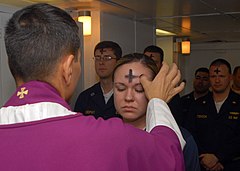Ash Wednesday is a big day for Roman Catholics, since this is the first day of the Lenten season. It is a day when ashes of palm crosses blessed in the previous Palm Sunday is mixed in sacred oils or holy water and the resulting paste is used by the minister or priest to make a sign of the cross, first upon his own forehead and then to the congregation with the help of the Extraordinary Ministers of the Holy Communion if needed. In Palompon, Leyte it was observed that there are more congregants than last year. Some are saying that it was the result of the on going formation/seminars being held in different Baranggay/Barrio's of the town through family groupings called Basic Ecclesial Communities.
Ash Wednesday, in the Western Christian calendar, is the first day of Lent and occurs forty-six days (forty days not counting Sundays) before Easter. It is a moveable fast, falling on a different date each year because it is dependent on the date of Easter. It can occur as early as 4 February or as late as 10 March.
Ash Wednesday derives its name from the practice of placing ashes on the foreheads of adherents as a sign of repentance. The ashes used are typically gathered after the Palm Crosses from the previous year's Palm Sunday are burned. In the liturgical practice of some churches, the ashes are mixed with the Oil of the Catechumens[1] (one of the sacred oils used to anoint those about to be baptized), though some churches use ordinary oil. This paste is used by the minister who presides at the service to make the sign of the cross, first upon his own forehead and then on those of congregants.
At Masses and services of worship on this day, ashes are imposed on the foreheads of the faithful (or on the tonsure spots, in the case of some clergy). The priest, minister, or in some cases officiating layperson, marks the forehead of each participant with black ashes in the shape of a cross, which the worshipper traditionally retains until it wears off. The act echoes the ancient Near Eastern tradition of throwing ashes over one's head to signify repentance before God (as related in the Bible). The priest or minister says one of the following when applying the ashes:
Remember, O man, that you are dust, and unto dust you shall return.
Turn away from sin and be faithful to the Gospel.
Repent, and hear the good news.
Wednesday
The ashes used in the service of worship or Mass are sacramentals, not a sacrament. The ashes are blessed according to various rites proper to each liturgical tradition, sometimes involving the use of Holy Water. In some churches they are mixed with light amounts of water[2] or olive oil[3][4], which serve as a fixative. In most liturgies for Ash Wednesday, the Penitential psalms are read; Psalm 51 (LXX Psalm 50) is especially associated with this day.[5] The service also often includes a corporate confession rite.
In some of the free church liturgical traditions, other practices are sometimes added or substituted, as other ways of symbolizing the confession and penitence of the day. For example, in one common variation, small cards are distributed to the congregation on which people are invited to write a sin they wish to confess.
These small cards are brought forth to the altar table where they are burned.[6]
In the Roman Catholic Church, ashes, being sacramentals, may be given to anyone who wishes to receive them,[7][8] as opposed to Catholic sacraments, which are generally reserved for church members, except in cases of grave necessity.[9][10] Similarly, in most other Christian denominations ashes may be received by all who profess the Christian faith and are baptized.[11]
In the Roman Catholic Church, Ash Wednesday is observed by fasting, abstinence from meat, and repentance—a day of contemplating one's transgressions. The Anglican Book of Common Prayer also designates Ash Wednesday as a day of fasting. In the medieval period, Ash Wednesday was the required annual day of penitential confession occurring after fasting and the remittance of the tithe. In other Christian denominations these practices are optional, with the main focus being on repentance. On Ash Wednesday and Good Friday,
Roman Catholics between the ages of 18 and 59 are permitted to consume only one full meal, which may be supplemented by two smaller meals, which together should not equal the full meal. Some Roman Catholics will go beyond the minimum obligations demanded by the Church and undertake a complete fast or a bread and water fast. Ash Wednesday and Good Friday are also days of abstinence from meat (for those Catholics age 14 and over), as are all Fridays in Lent. Some Roman Catholics continue fasting during the whole of Lent,[citation needed] as was the Church's traditional requirement,[citation needed] concluding only after the celebration of the Easter Vigil.
As the first day of Lent, Ash Wednesday comes the day after Shrove Tuesday or Mardi Gras (Fat Tuesday), the last day of the Carnival season.[12]

No comments:
Post a Comment